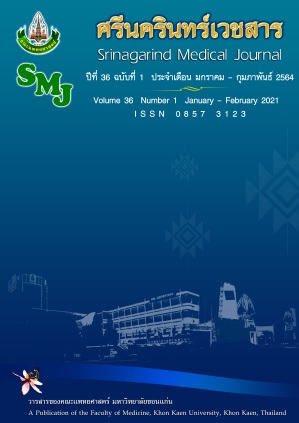Effect of Learning Program on Nurse’ Knowledge and Skill Improvement in Caring for Patients with Cleft Lip-Cleft Palate, Khon Kaen, Thailand
Keywords:
Learning programs; Knowledge; Satisfaction; Clinical outcomes; Cleft lip-palateAbstract
Objective: To evaluate pre- and post-knowledge of nurses through the usage of learning program in caring for patients with Cleft Lip and/or Palate, including users’ satisfaction and clinical outcomes.
Methods: Experimental study was conducted in a separated group of nurses who participated in an education program on nurses' knowledge in caring for patients with cleft lip-cleft palate. Both theoretical and skill training had been provided for 2 days. Data collection was done using pre- and post-test, satisfaction evaluation, and clinical outcomes assessment.
Results: The survey on 36 female nurses with age range of 40-49 years old found a statistically significant increase in overall knowledge score (xˉ = 77.86, df = 16.64, CI = 13.50-19.78., p <0.05) had the highest level of satisfaction with the overall learning program (4.59±0.63). Clinical outcomes revealed that among 18 patients in total with age range of 4-60 months, 11 patients were female and had cleft lip and cleft palate (61.11 percent). Significantly, the clinical outcomes were compatible with 5 target values.
Conclusion: Learning Program on Nurses’ Knowledge and skill in Caring for Patients with Cleft Lip and/or Palate is usable. The nurses revealed higher score in issues and in overall with statistical significance. The nurses satisfied with the program and gained the opportunity to develop knowledge and skill which is useful in patient care. Clinical outcomes are at satisfied level, so this learning program should be distributed in broader scale.
References
2. บวรศิลป์ เชาวน์ชื่น, ผกาพรรณ เกียรติชูสกุล, บรรณาธิการ. คู่มือผู้ปกครอง: ภาวะปากแหว่ง เพดานโหว่ และความพิการแต่กำเนิดของศีรษะและใบหน้า ทำความรู้จัก ทราบสาเหตุ อุบัติการณ์ และการป้องกัน. ขอนแก่น: ศูนย์วิจัยผู้ป่วยปากแหว่ง เพดานโหว่และความพิการแต่กำเนิดของศีรษะและใบหน้า คณะแพทยศาสตร์ มหาวิทยาลัยขอนแก่น; 2554.
3. Berger ZE, Dalton LJ. Coping with a cleft: psychosocial adjustment of adolescents with a cleft lip and palate and their parents. Cleft Palate Craniofac J 2009; 46: 435–443.
4. Reddy NK, Cronin ED. Physical impairments, psychological impact, and risk factors of cleft lip and palate in children from a surgical mission project in Armenia, Colombia. EC Dent Sci 2017; 9: 53–59.
5. บวรศิลป์ เชาวน์ชื่น, เบญจมาศ พระธานี, จารุณี รัตนยาติกุล, บรรณาธิการ. การดูแลแบบสหวิทยาการของผู้ป่วยปากแหว่ง เพดานโหว่ และความพิการแต่กำเนิดของใบหน้า และกะโหลกศีรษะ. ขอนแก่น: ศิริภัณฑ์ออฟเซท; 2547.
6. มยุรี ผิวสุวรรณ, ดารณี สุวพันธ์, วิไลภรณ์ โคตรบึงแก, ไฮเนกี้-มอทซ์ เค, แม็คเกลด บี, ปิยมาส อุมัษเฐียร. CBR Guidelines ขององค์การอนามัยโลก ฉบับภาษาไทย. กรุงเทพฯ: องค์การอนามัยโลก; 2556.
7. บวรศิลป์ เชาวน์ชื่น, เบญจมาศ พระธานี, สุธีรา ประดับวงษ์, บรรณาธิการ. คู่มือผู้ปกครองแนวทางการดูแลรักษาผู้มีภาวะปากแหว่ง เพดานโหว่. ขอนแก่น: ศูนย์วิจัยผู้ป่วยปากแหว่ง เพดานโหว่และความพิการแต่กำเนิดของศีรษะและใบหน้า คณะแพทยศาสตร์ มหาวิทยาลัยขอนแก่น; 2554.
8. Pradubwong S, Augsornwan D, Pathumwiwathana P, Prathanee B, Chowchuen B. Empowering volunteers at Tawanchai Centre for patients with cleft lip and palate. J Med Assoc Thai 2015; 98 (Suppl. 7): S47-53.
9. บวรศิลป์ เชาวน์ชื่น, สุธีรา ประดับวงษ์, บรรณาธิการ. สรุปผลงานประจำปีงบประมาณ 2560 ศูนย์การดูแลผู้ป่วยปากแหว่ง เพดานโหว่ และความพิการแต่กำเนิดของศีรษะและใบหน้า มหาวิทยาลัยขอนแก่น. ขอนแก่น: ศูนย์วิจัยผู้ป่วยปากแหว่ง เพดานโหว่และความพิการแต่กำเนิดของศีรษะและใบหน้า คณะแพทยศาสตร์ มหาวิทยาลัยขอนแก่น; 2560.
10. เทพฤทธิ์ พิณนาคิเลย์. การแบ่งประเภทประเภทของการประชุม [ออนไลน์]. 2558 [อ้างเมื่อ 4 กันยายน 2561]. จาก https://www.gotoknow.org/posts/85221
11. หัทยา อินทร์เชิง. ขั้นตอนการจัดอบรมโครงการเชิงปฏิบัติการ. กรุงเทพฯ: ภาควิชาพยาธิโปรโตซัว คณะเวชศาสตร์เขตร้อน มหาวิทยาลัยมหิดล; 2559.
12. ถวัลย์วงค์ รัตนสิริ. การวินิจฉัยและรักษาทารกในครรภ์ในปัญหาทางสูติศาสตร์ที่พบบ่อย. พิมพ์ครั้งที่ 1.
13. ขอนแก่น : สาขาวินิจฉัยและรักษาทารกในครรภ์ ภาควิชาสูติศาสตร์และนรีเวชวิทยา คณะแพทยศาสตร์
14. มหาวิทยาลัยขอนแก่น, 2561.
15. อรุณวรรณ อุดมเกษมทรัพย์, สุภามาศ ผาติประจักษ์, พิชญา ทองโพธิ์. ผลของการจัดโปรแกรมการสอนทักษะปฏิบัติการพยาบาลอุบัติเหตุ และฉุกเฉิน ต่อความรู้และการรับรู้สมรรถนะของตนเองในการปฏิบัติการพยาบาลอุบัติเหตุและฉุกเฉินของนักศึกษาพยาบาลชั้นปีที่ 4. วารสารพยาบาลและการศึกษา 2558; 8: 54–66.
16. ทิศนา แขมมณี. ศาสตร์การสอน: องค์ความรู้เพื่อการจัดกระบวนการเรียนรู้ที่มีประสิทธิภาพ. พิมพ์ครั้งที่ 19. กรุงเทพฯ: สำนักพิมพ์แห่งจุฬาลงกรณ์มหาวิทยาลัย; 2557.
17. Decker S, Sportsman S, Puetz L, Billings L. The evolution of simulation and its contribution to competency. J Contin Educ Nurs 2008; 39: 74–80.
18. Najjar RH, Lyman B, Miehl N. Nursing students’ experiences with high-fidelity simulation. Int J Nurs Educ Scholarsh 2015; 12: 1-9.
19. Hoffmann RL, O’Donnell JM, Kim Y. The effects of human patient simulators on basic knowledge in critical care nursing with undergraduate senior baccalaureate nursing students. Simul Healthc 2007; 2: 110–4.
20. Akhu-Zaheya LM, Gharaibeh MK, Alostaz ZM. Effectiveness of simulation on knowledge acquisition, knowledge retention, and self-efficacy of nursing students in Jordan. Clin Simul Nurs 2013; 9: e335–e342.
21. สุนิสา แสงวิเชียร. สรุปผลโครงการอบรมเชิงปฏิบัติการ “เทคนิคการเขียนรายงานการประชุม”[ออนไลน์] 2556 [อ้างเมื่อ 4 กันยายน 2561]. จาก https://bit.ly/2MNhNf6
22. Pradubwong S, Surit P, Chowchuen B. Evaluation of the comprehensive care program for patients with cleft lip – palate and craniofacial deformities. J Med Assoc Thai 2018; 101 (Suppl. 5): S89-96.




